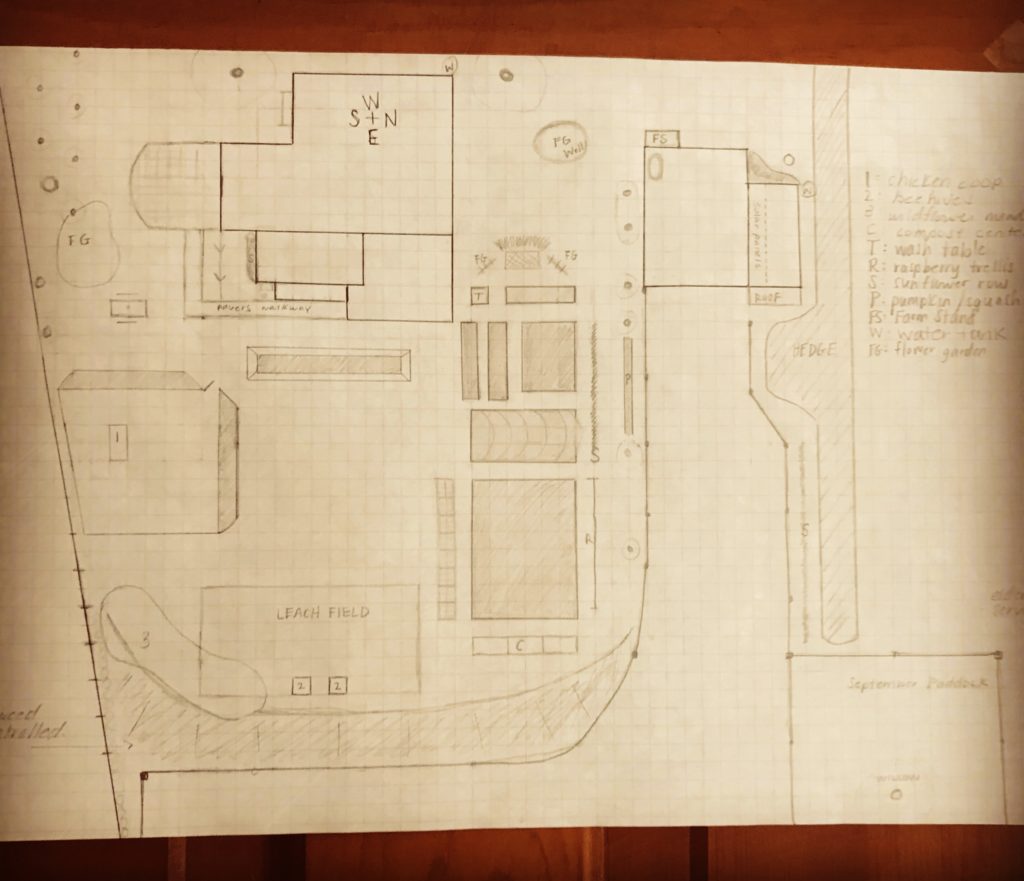I bought my first piece of property in my home state of New Hampshire in late October of 2015 after a markedly hot, dry summer. The meadow grasses were already golden and stiff as I moved the last of my belongings across the threshold. The first few nights I slept here were uncharacteristically warm for the season and I kept the windows opened, the rushing of the wind across the meadow a lullaby I hadn’t heard since living out west.
We have a lot of trees here in New Hampshire…and by a lot of trees I mean we are second only to Maine as the most forested of the contiguous United States. Open meadows are hard to come by in comparison to wooded lots and I was, and still am, enamored by the expansive view.
I knew I wanted to set some roots, both literally and figuratively, and while I was excited to get going, moving in October, a season associated with rest and respite rather than growth and cultivation, gave me some much needed time to quietly observe the cycles of the land.
It is common for many new homeowners to start ripping up their landscapes the minute they move in. Less common but still occurring are new farmers doing just the same. Sometimes this works out and the recently relocated aren’t stuck with unintended consequences…more oftentimes than not, these same people end up with sheds underwater come mud season and tender perennials that are decimated after the first snowfall. While sitting back and reading your property rather than working it may be akin to having a salted caramel brownie placed in front of you and not eating it, observing the lay of the land that first year is an investment in the success of your homestead.
I haven’t taken a permaculture course (yet). I am familiar with the principles because I am familiar with Nature. I recognize patterns of growth in the forest; I have seen what sprouts through patchwork snow and what lays in slumber below the soil until long after the spring thaw. I have noted that certain plants almost always grow near one another and many different species congregate around stonewalls and boulders. There are less species in basins and hollows compared to those on flat or sloping land although north-facing angles rarely house any soft vegetation.
I have seen windbreaks offer shelter to plants otherwise incapable of growing against the breeze and plants on top of a hill budding earlier than those at the bottom. With these observations in mind, I have attempted to replicate Nature when I first devised the layout for my own homestead and garden designs.
It was easy to figure out my orientation here at Sweet Birch. Using the handy dandy compass on my iPhone I was able to determine where the East met the South and the West met the North. A screenshot of my property on Google map offered a fairly accurate image of what I was working with in terms of meadowland and forest, stonewalls and structures. From here I started designing the things I know I wanted in order of priority. For me it looked a bit like this:

1st year:
- Chicken coop and run
- Compost center
- Raised beds
2nd year:
- Horse shed & paddock
- Additional Raised Beds
- Manure mitigation plan
3rd year:
- Cold frames
- Pollinator garden
- Raspberries/blackberries
- Farmstand up with herbs, veg. & eggs
4th year:
- Solar Electric to the Horse Shed
- Farmstand to include micro-greens
- Beehives?
5th year:
- Farmstand to include berries (honey?)
- Move
Yea. Move as in relocate in Year 5. I’m a bit nomadic and staying in one place for longer than five years gives me bone deep anxiety. That said, I’ve only ever been a renter so owning a property makes things a bit more difficult. This week (mid-March) I have a meeting with a real estate agent regarding the market here in my tiny town. I know housing here is liquid but it might be prudent to rent the property rather than sell it. What will happen to the horse and hens? Ideally they will move with me. My belongings? What I can’t sell to downsize I will place in storage.
I should note that all of the listed additions to the property are only semi-permanent. The electric fencing can be removed in a day and the chicken coop sold within weeks. Panda’s shed can be either relocated or repurposed if the new renters/buyers don’t have their own equine partner. The raised beds can be removed and tilled back into open lawn space should gardening not be in the cards for a new owner and if I actually go through with the beehive endeavor, the hives can be transported if need be.
The permanency of objects is important to consider when attempting a homestead. While many people are hoping for their forever homes when looking, for a lot of us, that isn’t the case. Whether because we outgrow the land or the land outgrows us, I think it is essential to evaluate how our decisions affect the future of the property as a resale. Does this mean you can’t make your house a home? Most certainly not. But making alterations that are too personalized can create a challenge if a better farm property suddenly becomes available or that dream job opens up in another state. A giant herb labyrinth might speak to your soul, but to a future buyer its message may suggest intensive work rather than zen work. I am not saying to go without but I am advising you to think from various perspectives rather than seeing your property solely through yours or your partner’s eyes.
I’m not sure if I will choose to leave this parcel as suggested in my Year 5 plans. Things can change and this house has become a home. My family is nearby and I’ve made some close friends this past year that pull my roots deeper into the soil here at Sweet Birch. Is the land perfect for what I want to do? Not even close. There are days when I look out at my waterlogged paddocks and find myself crying in utter despair. Then again, there are mornings when I watch the red orb of an early spring sun, rise from the behind the tree line and reflect on the sparkling snow below… and I find my cheeks dampen then too.

This property is right for now, but it isn’t just right. I will continue to scheme and experiment and work with the land to my best abilities until something more suitable arises. While I have set some roots here in Chester, they remain shallow even though they are of quality. The breeze has tickled from time to time with whispers on it breath, but it hasn’t had enough force to persuade me from this location…yet. When the time comes I will take what I’ve learned from Sweet Birch and apply it elsewhere. But for now I will embrace those sunrises, stick to my goals, and be thankful for my perfect for now home.
